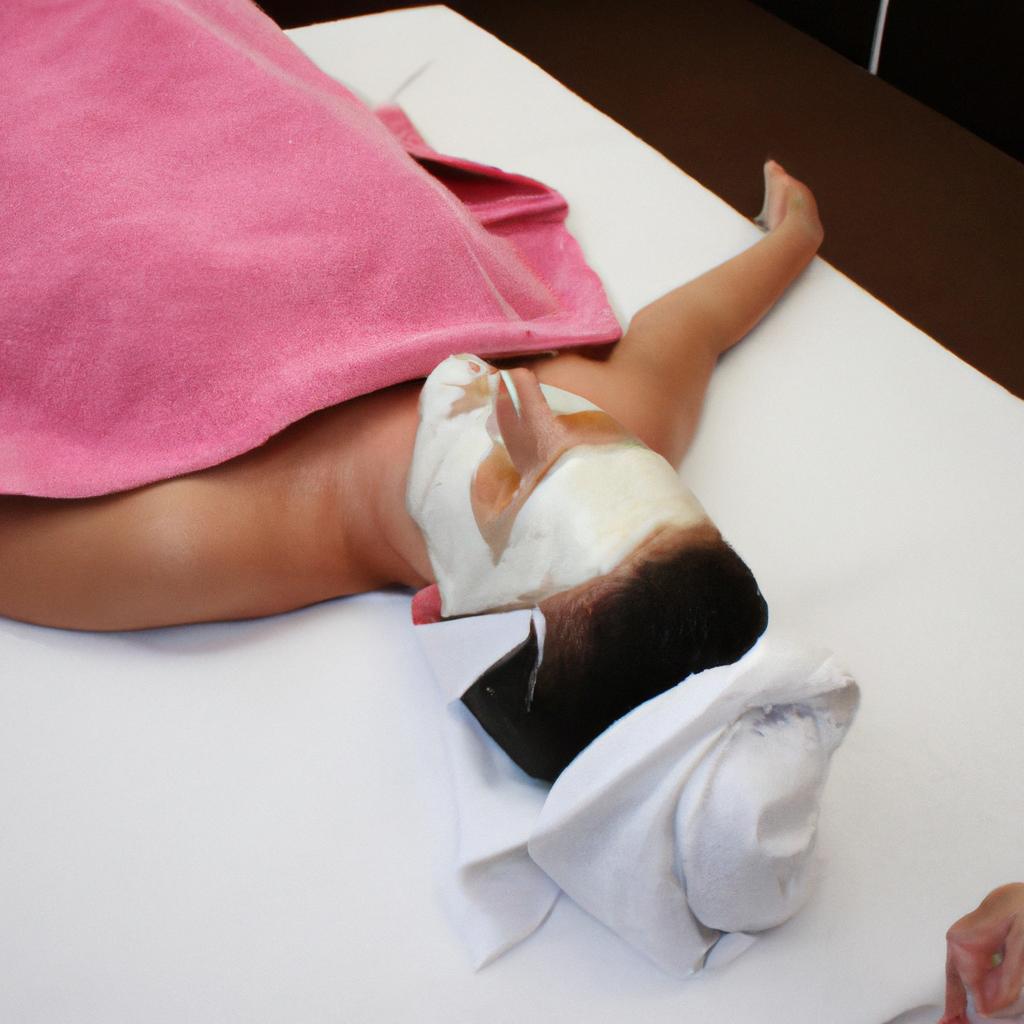Financial planning is a critical aspect of running a successful day spa business. Whether it’s obtaining the necessary funding for start-up costs or managing cash flow to ensure ongoing operations, spa owners must have a solid understanding of spa financing. In this article, we will explore various aspects of financial planning specifically tailored to day spas, offering insights into effective strategies and solutions.
One example that highlights the importance of financial planning in the day spa industry involves a hypothetical scenario where a new entrepreneur decides to open a luxurious wellness retreat center. Despite having an exceptional concept and a strong passion for providing top-notch services, they soon encounter challenges when seeking financing options. Without adequate knowledge about spa financing, they struggle to articulate their financial needs and projections to potential lenders or investors, ultimately hindering their ability to secure the necessary funds. This case study underscores the need for comprehensive financial planning as an indispensable tool for aspiring and existing day spa owners alike.
By delving into topics such as budgeting, revenue forecasting, cost management, and loan acquisition strategies specific to the day spa sector, this article aims to provide valuable guidance on how to navigate the complex world of finance effectively. Understanding these principles will not only enable day spa owners to make informed decisions but also empower them with the skills necessary to to achieve financial stability and sustainable growth in their business.
One key aspect of financial planning for day spas is budgeting. Creating a detailed budget allows owners to track their expenses, identify areas where costs can be reduced, and allocate resources effectively. By establishing a comprehensive budget that includes all operational expenses, such as rent, utilities, employee wages, product inventory, marketing efforts, and maintenance costs, spa owners can gain a clear understanding of their financial obligations and make informed decisions about pricing strategies and revenue goals.
Revenue forecasting is another crucial component of financial planning for day spas. By analyzing historical data, market trends, and industry benchmarks, owners can project future income streams accurately. This helps in setting realistic sales targets and enables effective resource allocation. Revenue forecasting also assists in identifying peak seasons or slow periods within the year when additional marketing efforts or cost-saving measures may be necessary.
Cost management plays a vital role in achieving profitability for day spas. Owners should regularly review their operating expenses and evaluate ways to optimize costs without compromising on quality. This may involve negotiating better deals with suppliers, implementing energy-efficient practices to reduce utility bills, or streamlining staffing schedules to avoid unnecessary labor costs.
When it comes to financing options for day spas, there are various avenues to explore. Traditional bank loans are one option but may require a solid business plan and collateral. Other alternatives include Small Business Administration (SBA) loans specifically designed for small businesses or seeking investments from private investors who understand the spa industry’s potential for growth.
In conclusion, financial planning is indispensable for day spa owners looking to establish a successful business venture or expand an existing one. By incorporating effective strategies such as budgeting, revenue forecasting, cost management, and exploring suitable financing options tailored to the day spa sector’s unique needs, owners can navigate the complexities of finance confidently while ensuring long-term sustainability and profitability.
Understanding the financial needs of day spas
Imagine a scenario where Sarah, an aspiring entrepreneur, decides to open her own day spa. She envisions a serene and luxurious space that offers a range of beauty and wellness treatments to help clients unwind and rejuvenate. As Sarah starts planning her venture, she quickly realizes that financial considerations are crucial for turning her dream into reality.
Financial planning is essential for day spas to ensure their smooth operation and long-term success. To grasp the intricacies of spa financing, it is important to understand the specific financial needs unique to this industry.
Firstly, establishing a day spa requires significant upfront investment in infrastructure and equipment. From massage tables to skincare products, furnishing the facility with high-quality amenities can incur substantial costs. Additionally, securing suitable premises in prime locations often comes at a premium price.
Secondly, operational expenses such as rent, utilities, staffing costs, marketing efforts, and ongoing product replenishment must be carefully managed. These recurring expenditures can strain cash flow if not adequately accounted for in the business plan.
Lastly, maintaining sufficient working capital is vital for covering unforeseen expenses or seasonal fluctuations in customer demand. Having enough funds on hand allows day spas to weather temporary downturns without compromising service quality or jeopardizing growth opportunities.
To fully comprehend the financial challenges faced by day spas, consider the following bullet points:
- Day spas require initial investments in infrastructure and equipment.
- Operating costs include rent, utilities, staff salaries, marketing expenses,
and supplies. - Adequate working capital ensures resilience during periods of low demand
or unexpected emergencies. - Profit margins may vary depending on factors like location and target market.
Table: Factors Influencing Spa Financial Needs
| Factor | Impact |
|---|---|
| Location | Higher rents may increase operating costs |
| Target Market | Different demographics affect profitability |
| Competitors | Increased competition may reduce profit margins |
| Economic Conditions | Recessionary periods may lead to decreased demand |
Understanding the financial needs of day spas is essential for entrepreneurs like Sarah to develop a comprehensive business plan. By recognizing the specific challenges and requirements, she can make informed decisions regarding funding sources and financial management strategies.
Transitioning into the subsequent section about exploring different financing options for spa businesses, it becomes evident that understanding these needs will serve as a solid foundation for making sound financial choices throughout the establishment and operation of a day spa venture.
Exploring different financing options for your spa business
Understanding the financial needs of day spas is crucial for successful business planning. Let’s consider an example to illustrate this point: Imagine a newly opened day spa in a bustling urban area. The owners have invested in state-of-the-art equipment, luxurious furnishings, and hired a team of experienced therapists. However, they soon realize that without proper financing, their dream venture may struggle to survive.
To ensure the smooth functioning and growth of a day spa, it is essential to identify and address its specific financial requirements. Here are some key considerations:
-
Start-up costs: Day spas typically require significant upfront investment for leasehold improvements, purchasing equipment and supplies, legal fees, marketing expenses, and working capital. Having a clear understanding of these start-up costs is vital when seeking financing options.
-
Operational expenses: Day spas have regular operational expenses such as rent or mortgage payments, utilities, insurance premiums, payroll costs, inventory replenishment, advertising campaigns, and ongoing maintenance. These recurring expenses should be factored into the financial plan to determine cash flow requirements.
-
Seasonality: Many day spas experience seasonal fluctuations in customer demand throughout the year. For instance, there might be increased footfall during holiday seasons or special occasions like Valentine’s Day or Mother’s Day. Adequate financial planning must account for these variations in order to maintain stability during slower periods.
-
Revenue streams: Apart from traditional spa services like massages and facials, day spas can generate additional revenue through retail sales of skincare products or by offering specialized treatments like acupuncture or wellness programs. Diversifying revenue streams helps create resilience against market changes.
Consider the following table highlighting examples of different revenue sources for day spas:
| Revenue Stream | Description |
|---|---|
| Spa Services | Massages, facials, body wraps |
| Retail Sales | Skincare products |
| Wellness Programs | Yoga classes, meditation sessions |
| Partnerships | Collaboration with local hotels or wellness resorts for joint promotions and package deals |
Understanding the financial needs of day spas, including start-up costs, operational expenses, seasonality, and revenue streams, is essential when seeking financing options. By carefully considering these factors, spa owners can make informed decisions to ensure their business remains financially stable and successful.
Now let’s explore different financing options available for day spas in the next section by discussing various loans and funding sources.
Key factors to consider before applying for a spa loan
Exploring different financing options for your spa business can be an important step in ensuring its success. One key option to consider is obtaining a loan specifically tailored for spas, which can provide the necessary funds to cover various expenses such as equipment purchases, renovations, or working capital. Let’s take a closer look at some common types of spa loans and their features.
For example, one popular financing option is a traditional bank loan. These loans typically offer competitive interest rates and longer repayment terms than other alternatives. However, they often require extensive documentation and collateral, making them more suitable for established businesses with strong credit histories.
Another potential avenue is Small Business Administration (SBA) loans. SBA loans are guaranteed by the government and offered through approved lenders. They offer favorable terms such as lower down payments and longer repayment periods but require thorough paperwork and may have stricter eligibility criteria compared to conventional bank loans.
Additionally, there are alternative lending options available that cater specifically to small businesses like day spas. Online lenders have emerged as convenient choices, offering quick approval processes and flexible repayment terms. While these loans may come with higher interest rates due to the increased risk associated with unsecured lending, they can be viable solutions for spa owners who need immediate funding without stringent requirements.
When considering different financing options for your spa business, keep in mind several factors that will impact your decision-making process:
- Interest rates: Compare rates from different lenders to ensure you secure the most affordable option.
- Repayment terms: Evaluate the length of time you’ll have to repay the loan while considering how it aligns with your cash flow projections.
- Eligibility requirements: Understand what qualifications each lender looks for before applying to increase your chances of approval.
- Additional fees: Be aware of any origination fees or prepayment penalties attached to the loan agreement.
By carefully examining these factors alongside individual circumstances and needs specific to your spa business, you can make an informed decision on which financing option is the best fit.
Transitioning into the subsequent section about “The importance of budgeting and cash flow management,” it is essential to consider these aspects before applying for a spa loan. Proper financial planning, including budgeting and managing cash flow effectively, can significantly impact your ability to secure funding and maintain long-term success in the competitive spa industry.
The importance of budgeting and cash flow management
When considering financing options for your day spa, it is important to evaluate several key factors that can significantly impact the success of your business. One such factor is the interest rate associated with the loan. For instance, let’s consider a hypothetical scenario where a day spa owner applies for two different loans: one with an interest rate of 5% and another with an interest rate of 10%. The difference in rates may not seem significant initially, but over time, it can have a substantial effect on the overall cost of borrowing.
Another crucial consideration is the repayment terms offered by the lender. In our case study, Loan A offers a shorter repayment period of five years while Loan B allows for ten years. Although opting for Loan A means higher monthly payments, it also results in less total interest paid compared to Loan B. However, this decision must be evaluated based on your cash flow projections and financial stability.
Additionally, evaluating any potential fees associated with obtaining the loan is essential. Some lenders charge origination fees or other upfront costs that can add up quickly. It is crucial to calculate these expenses into your budget plan to determine if they are feasible without jeopardizing your ability to meet other financial obligations.
Lastly, understanding the impact of the loan on your credit score should not be overlooked. Taking out a significant amount of debt can affect your creditworthiness and potentially hinder future financing opportunities or result in higher interest rates down the line.
Considering these key factors will help you make informed decisions when selecting a suitable financing option for your day spa venture:
- Interest rate comparison: Analyze multiple loan options from various lenders to find competitive rates.
- Repayment term evaluation: Assess both short-term affordability and long-term implications when choosing between longer or shorter repayment periods.
- Fee assessment: Carefully review all fees associated with each loan offer to avoid unexpected costs.
- Credit score impact: Understand the potential effects on your credit rating and future borrowing capabilities.
By carefully considering these factors, you can make an informed decision about which loan option is most suitable for your day spa business.
Tips for negotiating favorable loan terms and interest rates
Transitioning from the importance of budgeting and cash flow management, it is crucial for day spas to understand how to negotiate favorable loan terms and interest rates when seeking financing. Let’s explore some tips that can help spa owners secure more advantageous financial arrangements.
For instance, imagine a day spa owner named Sarah who wants to expand her business by opening a second location. To fund this expansion, Sarah decides to apply for a small business loan. By following these negotiating strategies, Sarah increases her chances of securing favorable loan terms:
-
Prepare thoroughly: Before approaching lenders, Sarah gathers all the necessary documentation such as financial statements, tax returns, and projections. This demonstrates her preparedness and professionalism, making it easier for lenders to trust in her ability to repay the loan.
-
Shop around: Sarah understands the importance of comparing different lenders’ offers rather than settling on the first one she encounters. By soliciting multiple proposals, she gains leverage in negotiations and increases her likelihood of finding lower interest rates or better repayment terms.
-
Highlight collateral: In order to mitigate risk for lenders, Sarah emphasizes any collateral she can offer as security against the loan. Whether it be property owned by the business or personal assets like equipment or vehicles, showcasing tangible assets strengthens her bargaining power.
-
Leverage creditworthiness: If Sarah has maintained good credit scores both personally and professionally, she can use them as leverage during negotiations with potential lenders. A strong credit history signals reliability and reduces perceived risks associated with lending money.
To illustrate these points further, let’s take a look at an example table comparing two hypothetical scenarios where spa owners are seeking financing:
| Spa Owner A | Spa Owner B | |
|---|---|---|
| Loan Amount | $100,000 | $100,000 |
| Interest Rate | 7% | 9% |
| Repayment Term | 5 years | 7 years |
| Collateral | None | Equipment |
In this table, it is evident that Spa Owner A secured a more favorable loan with a lower interest rate and shorter repayment term. This example emphasizes the importance of negotiating for better terms to ensure financial success in spa financing.
By implementing these tips and strategies during negotiations, day spa owners like Sarah can increase their chances of securing advantageous financing arrangements. In the following section, we will discuss common challenges and pitfalls to avoid when navigating the world of spa financing.
Common challenges and pitfalls to avoid in spa financing
Transitioning from the previous section on negotiating favorable loan terms and interest rates, it is essential for day spas to be aware of common challenges and pitfalls that can arise during the process of spa financing. By understanding these potential obstacles, spa owners can better navigate their financial planning journey and make informed decisions.
For instance, consider a hypothetical case where a day spa owner seeks financing to expand their business operations. They approach multiple lenders but fail to adequately research each lender’s requirements and expectations. As a result, they may encounter difficulties securing a loan or end up with unfavorable terms due to lack of preparation.
To ensure smooth spa financing, here are some common challenges and pitfalls that should be avoided:
-
Insufficient documentation: Providing accurate and comprehensive financial records is crucial when seeking funding for your day spa. Incomplete or inaccurate documentation can lead to delays in the approval process or even rejection of the loan application. Be prepared by organizing all necessary documents such as tax returns, profit/loss statements, balance sheets, and cash flow projections.
-
Lack of contingency planning: It is important to have a backup plan in case unexpected circumstances arise during the repayment period. Failure to anticipate potential risks like economic downturns or changes in market conditions could put strain on your ability to meet loan obligations promptly.
-
Overestimating revenue projections: While optimism is commendable, it is vital not to overestimate revenue projections when applying for spa financing. Lenders expect realistic forecasts based on industry benchmarks and historical data. Failing to provide accurate projections may undermine your credibility as a borrower.
-
Ignoring alternative funding options: Relying solely on traditional bank loans might limit your chances of obtaining adequate financing for your day spa venture. Exploring alternative funding sources such as small business grants, crowdfunding platforms, or partnerships with investors can offer additional avenues for capital infusion.
Consider the following table that highlights the potential challenges and corresponding strategies to overcome them:
| Challenges | Strategies |
|---|---|
| Insufficient documentation | Ensure all financial records are accurate and complete |
| Lack of contingency planning | Develop a comprehensive backup plan |
| Overestimating revenue projections | Use realistic industry benchmarks for forecasting |
| Ignoring alternative funding options | Explore non-traditional sources of financing |
In summary, day spa owners must be aware of the common challenges and pitfalls involved in spa financing. By avoiding these obstacles, such as insufficient documentation or overestimating revenue projections, spa owners can increase their chances of obtaining favorable loan terms and successfully expanding their businesses. Through proper preparation and consideration of alternative funding options, you can navigate the complexities of spa financing with confidence.




